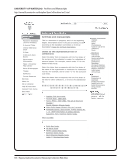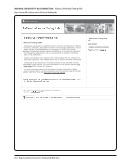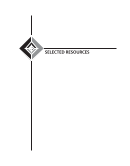SPEC Kit 307: Manuscript Collections on the Web · 19
Survey Questions and Responses
The SPEC survey on Manuscript Collections on the Web was designed by Donnelly Lancaster Walton,
Archival Access Coordinator, W.S. Hoole Special Collections Library, University of Alabama. These results
are based on data submitted by 72 of the 123 ARL member libraries (59%) by the deadline of March 31, 2008.
The survey’s introductory text and questions are reproduced below, followed by the response data and
selected comments from the respondents.
Most of those in the archival profession have heard the casual yet emphatic question from patrons, “Why isn’t this information on
your Web site?” In the 1990s, simply posting hours of operation, basic policies, contact information, and a digital image or two may
have been enough to keep patrons, staff, and top-level administration content. In 2008, however, this minimal information is not
enough for anyone on any level. Now more than ever, staff in archival repositories feel pressure from administrators, colleagues, and
patrons to increase the amount and types of information they make available on their Web sites for public consumption.
A casual review of Web sites for various libraries and other cultural institutions shows a wide range of materials in their collections
and an equally wide range of approaches to describing collections, including collection surrogates, and presenting visually
interesting pages. One repository’s Web site may offer an appealing appearance with digital exhibits and links to large digital
projects, descriptions of the types of materials available at the repository, and a few finding aids marked up in Encoded Archival
Description (EAD). Another Web page may have rather plain themes and appearance, offer few or no digital surrogates of its
materials, and no finding aids marked up in EAD, but have descriptions of ALL of its materials and finding aids available in some
format. Other archival repository Web sites have a variety of combinations of description, surrogates, and appearance.
Administrators often look to the more visually interesting Web sites with digital images and large numbers of collection lists and
finding aids as an ideal their institution should strive to reach. What these Web sites do not always reveal is how representative of
the manuscript collections the sites really are, how much work was required, and how much help the processing archivists had in
getting the information out there.
This survey will investigate how many manuscript collections are held in ARL member libraries what percentage of these collections
are represented on the Web what types of information about the collections are available in finding aids and on the Web what
formats are used for finding aids on the Web how many library staff are working on manuscript collections, the challenges and
benefits of migrating collection information to the Web, and whether and how usage of manuscript collection information is
tracked.
Survey Questions and Responses
The SPEC survey on Manuscript Collections on the Web was designed by Donnelly Lancaster Walton,
Archival Access Coordinator, W.S. Hoole Special Collections Library, University of Alabama. These results
are based on data submitted by 72 of the 123 ARL member libraries (59%) by the deadline of March 31, 2008.
The survey’s introductory text and questions are reproduced below, followed by the response data and
selected comments from the respondents.
Most of those in the archival profession have heard the casual yet emphatic question from patrons, “Why isn’t this information on
your Web site?” In the 1990s, simply posting hours of operation, basic policies, contact information, and a digital image or two may
have been enough to keep patrons, staff, and top-level administration content. In 2008, however, this minimal information is not
enough for anyone on any level. Now more than ever, staff in archival repositories feel pressure from administrators, colleagues, and
patrons to increase the amount and types of information they make available on their Web sites for public consumption.
A casual review of Web sites for various libraries and other cultural institutions shows a wide range of materials in their collections
and an equally wide range of approaches to describing collections, including collection surrogates, and presenting visually
interesting pages. One repository’s Web site may offer an appealing appearance with digital exhibits and links to large digital
projects, descriptions of the types of materials available at the repository, and a few finding aids marked up in Encoded Archival
Description (EAD). Another Web page may have rather plain themes and appearance, offer few or no digital surrogates of its
materials, and no finding aids marked up in EAD, but have descriptions of ALL of its materials and finding aids available in some
format. Other archival repository Web sites have a variety of combinations of description, surrogates, and appearance.
Administrators often look to the more visually interesting Web sites with digital images and large numbers of collection lists and
finding aids as an ideal their institution should strive to reach. What these Web sites do not always reveal is how representative of
the manuscript collections the sites really are, how much work was required, and how much help the processing archivists had in
getting the information out there.
This survey will investigate how many manuscript collections are held in ARL member libraries what percentage of these collections
are represented on the Web what types of information about the collections are available in finding aids and on the Web what
formats are used for finding aids on the Web how many library staff are working on manuscript collections, the challenges and
benefits of migrating collection information to the Web, and whether and how usage of manuscript collection information is
tracked.








































































































































































































